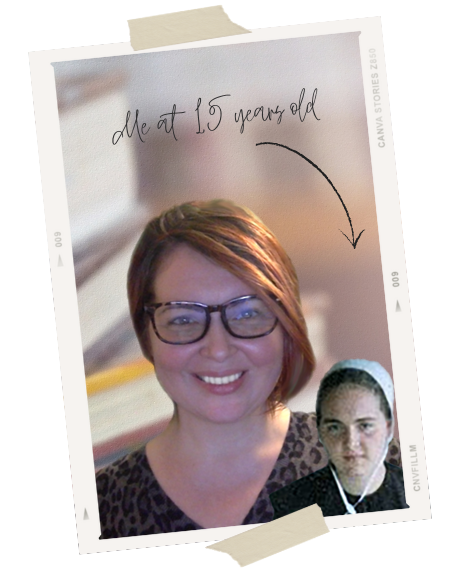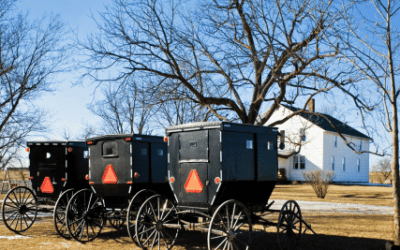Part 2 of 4 – See This Devastating Lawsuit Destroys Your Right to Learn for Part 1
For the Amish, the 1972 US Supreme Court case Wisconsin v. Yoder disputes were about retaining the ability to force a child to work for free—and thereby reduce payroll expenses—and to keep the child ignorant of their rights as a US citizen, rights that supersede Amish law. Making it about religion was a convenient cover.
But for the National Committee for Amish Religious Freedom, a non-Amish special interest group that hired the attorneys and paid the legal bills for the Amish, Yoder was about using the Amish as a guinea pig to see how far they could push religious freedom provisions for the benefit of the Committee’s non-Amish purposes.
What outsiders don’t understand, and which of course was never revealed in the court hearings, is that in most Amish families, children aren’t allowed to keep any of the money they earn until, depending on the family, the male child is eighteen to twenty-one years old and the female child is twenty to twenty-one years old. Every paycheck before that age goes to the father. And none of it is deposited in a trust for the child. That’s slave labor and child abuse.
Educational Deprivation, a Tool for Maintaining Power and Control
The Religious Right wants the general public to believe that there were no private religious schools before Yoder, or that overturning Yoder will result in one’s religious freedom being taken away. That’s simply not true. Both Iowa and Wisconsin frequently made reasonable religious accommodations for the Amish leading up to each state’s pivotal events. In addition, religions such as Catholic, Protestant, and Quaker had their own schools. In fact, schools in the US were first started by religious organizations, not the government. Except Cornell and the University of Pennsylvania, the Ivy League universities—among the oldest educational institutions in the US—were started by churches or individuals affiliated with a church for the purpose of religious instruction.11 My alma mater, Columbia University, still uses its original motto, which is from a Bible verse: In lumine Tuo videbimus lumen (“In your light we see light”) (New Revised Standard Version, Psalms 36:9).12
11. Although the University of Pennsylvania wasn’t formed for the primary purpose of teaching theology, its first Provost was a minister, Reverend William Smith: Friedman, Steven Morgan. “A Brief History of the University of Pennsylvania.” Penn University Archives & Records Center, University of Pennsylvania, archives.upenn.edu/exhibits/penn-history/brief-history. Accessed 25 Mar. 2019. 12. “Columbia University at a Glance.” Office of Public Affairs, Columbia University, www.columbia.edu/cu/pr/special/cuglance.html. Accessed 25 Mar. 2019.
During the unrest of the sixties, some Amish families moved away from Buchanan County to Green County, Wisconsin. The Amish in that Wisconsin community, including Jonas Yoder, the lead plaintiff in the Yoder case, sent their children to public school, until it became clear that the state would enforce the compulsory education law. Yoder had no problem with his children being exposed to non-Amish values until it interfered with his access to free labor: he wanted his children to work for him full-time after the eighth grade.
The State of Wisconsin wasn’t as compromising as Iowa when it came to making exemptions for children from compulsory education after age fourteen. In 1968 the Wisconsin Amish opened their own school in an effort to slide under the radar. However, public school superintendent Kenneth Glewen followed up and discovered that a number of children should have been attending ninth and tenth grades.
Glewen was motivated to enforce Wisconsin’s law because the more students who attended public school, the more state funding his district received.13 While Glewen’s actions seem to have been purely selfish, with no regard for Amish children’s educational welfare, that lack of regard was no different from Yoder’s and the other Amish men who refused to send their children to school past the eighth grade. These Amish men were interested only in free labor. Although argued from a seemingly religious perspective, neither the Iowa nor Wisconsin conflicts were driven by a genuine concern over the spiritual welfare of the children. For the Amish, the disputes were about retaining the ability to force a child to work for free—and thereby reduce payroll expenses—and to keep the child ignorant of their rights as a US citizen, rights that supersede Amish law. Making it about religion was a convenient cover.14 But for the National Committee for Amish Religious Freedom, a non-Amish special interest group that hired the attorneys and paid the legal bills for the Amish, Yoder was about using the Amish as a guinea pig to see how far they could push religious freedom provisions for the benefit of the Committee’s non-Amish purposes.15
13. Although the University of Pennsylvania wasn’t formed for the primary purpose of teaching theology, its first Provost . Linder, Douglas. “Yoder v Wisconsin: The Amish Challenge Compulsory Education Laws.” Famous Trials, University of Missouri-Kansas City School of Law, law2.umkc.edu/faculty/projects/ftrials/conlaw/YoderStory.html. Accessed 25 Mar. 2019. 14. Today, none of the plaintiffs (Jonas Yoder, Wallace Miller, and Adin Yutzy) in Wisconsin v. Yoder are members of the Amish Church. Yutzy was a member of the Beachy Amish but the case was ruled based on the traditional Amish Church, not Beachy. 15. Linder, Douglas. “Yoder v Wisconsin: The Amish Challenge Compulsory Education Laws.” Famous Trials, University of Missouri-Kansas City School of Law, law2.umkc.edu/faculty/projects/ftrials/conlaw/YoderStory.html. Accessed 25 Mar. 2019. NOTE: By now-retired Mennonite sociologist Donald Kraybill’s own admission, his career came about as a direct result of being involved in Yoder as a research assistant for John A. Hostetler, who was an Amish-raised sociologist whose work in the 1950s and 1960s led to Kraybill’s creation of the field of Amish Studies. Until his death, Hostetler was a member of the Committee and to date, Kraybill is a member.
What outsiders don’t understand, and which of course was never revealed in the court hearings, is that in most Amish families, children aren’t allowed to keep any of the money they earn until, depending on the family, the male child is eighteen to twenty-one years old and the female child is twenty to twenty-one years old. Every paycheck before that age goes to the father. And none of it is deposited in a trust for the child. That’s slave labor and child abuse.16
16. As early as age twelve, I worked ten-hour shifts picking asparagus for commercial growers in Michigan. By age fourteen, I worked twelve- to fourteen-hour shifts in an Amish bakery. I was forced to turn over every penny I earned to my father.
In most cases, a female child is married before she’s of the age allowed to keep what she earns and hence, the majority of Amish women have no idea how to manage money and be financially self-sufficient. Consider also that married women aren’t allowed to have a paying job; the exception is if the job is a home-based business, in which case the husband—except in rare instances—controls the money even if he himself doesn’t earn it from that business.
This financial illiteracy and dependence on the male is designed to maintain control over girls and women and prevent them from upward mobility. This also means that they have no way out from abusive situations. Fathers, husbands, bishops, clergy members, and adult sons all enjoy a higher status than women and girls. How is a female to provide for herself if she doesn’t have access to transportation, a roof over her head, and a job that pays enough for her to make the rent? How is she to even begin if she doesn’t have a social security number? Such challenges are difficult enough for a single female. Imagine how next to impossible it is for a married woman with a dozen children. How is a woman in that situation to exit an abusive marriage, when the Church forbids divorce, refuses to provide shelter and funding to battered wives and children, and punishes anyone who reports to law enforcement or outside agencies?
Similar to financial dependence, educational deprivation is ultimately for the purpose of making it next to impossible for any child to smoothly and successfully transition to a life and community outside of the Church. Yoder explicitly acknowledges this, and approves of it: “During [the adolescent] period, the children must acquire Amish attitudes favoring manual work … and the specific skills needed to perform the adult role of an Amish farmer or housewife. They must learn to enjoy physical labor. … And, at this time in life, the Amish child must also grow in [the Amish] faith and his relationship to the Amish community….”17
17. Wisconsin v. Yoder. 406 U.S. 205. Supreme Court of the United States. 1972. Supreme Court Collection, Legal Information Institute, Cornell Law School, www.law.cornell.edu/supremecourt/text/406/205. Accessed 25 Mar. 2019.
Thanks to Yoder, we’ve been stunted in our development, both as children and as adults. We’re a nation of eighth graders, an ethnic minority that doesn’t speak English fluently. A good percentage of us don’t make it through the eighth grade or perform above a C or D.18 We’re forbidden from learning about science, technology, engineering, math, mental health, world history, music, current affairs, law, civics, the arts, and sex education. We don’t even have words in our Amish language for “vagina” and “penis.”
18. One of my classmates failed or barely passed most of his subjects every year; Joe Slabaugh, no longer practicing Amish, made it through the third grade only. In general, we learn only the three Rs (reading, writing, arithmetic) from 1950s-1970s textbooks taught by teachers who haven’t advanced beyond the eighth grade themselves. In my first year of high school, all my chemistry classmates laughed at me when I raised my hand and asked, “What does h2o mean?” And today many Amish children will never have heard of 9/11.
Yoder was justified on the premise that the only future for every Amish child is an Amish agrarian one inside the Amish Church. However, we’re no longer an agrarian people. The Amish family farm can’t compete with Big Ag, Silicon Valley, and globalization. The Amish child of today doesn’t have the same occupational path as the Amish child of 1972. But still our children (who grow up to be adults who repeat this educationally deprived cycle) are stuck with an inadequate education, with insufficient knowledge—or none at all—of climate change, artificial intelligence, the global economy, national and world affairs, health issues, human gene editing, GMOs, human trafficking, pedophilia, STDs, transhumanism, and dangerous drugs, etc. We’re expected to be able to put food on our table in the same way that we did in 1972. Yoder fantasized that we’d remain frozen in time. The outside world would change, but we wouldn’t.
This idea that we should remain frozen in time is perpetuated by self-proclaimed experts on us Amish who are neither Amish nor have they bothered to learn our language.19 Furthermore, with minor exceptions, their publications are based on interaction with Amish men only. The women’s voices aren’t represented. And the children’s voices aren’t represented. For example, the sociologist Donald Kraybill’s entire body of thirty-plus years of Amish “literature” is based on responses from male-only eighth graders—men who speak English as a second language, don’t know what H2O means, and ignorantly agree with whatever narrative Kraybill wants. What are those “experts”’ stakes in maintaining a rosy myth about us, one with devastating consequences in real life? The story that these academics crank out enables the abuse of Amish children. It manufactures an image that denies that the children are suffering. It makes sure that Amish rapists and child molesters’ interests are protected: by claiming that there’s no crime among us, or that we take care of our own issues, the criminals are free to continue to prey upon victims.
19. With the exception of John Hostetler, I know of no one raised traditional Amish who is or was an academic. It’s quite possible more academics exist but I haven’t found them or been informed about them. Hostetler doesn’t accurately represent us traditional Amish and he refused to fight for Amish children’s rights to a quality education; instead, he provided expert testimony in favor of the parents in Wisconsin v. Yoder. Of all people, he should have advocated for the children because he himself left the Church in pursuit of higher learning. This legacy of insisting that Amish children aren’t harmed by being forced to stop going to school after the Amish eighth grade continues in Donald Kraybill’s Amish Studies industry. Time and time again, professors and others connected to Kraybill and affiliated with higher education––usually men––tell me that I’m wrong for wanting to overturn Yoder and that Amish children don’t need an education beyond whatever the Amish Church decides is good enough for them. For example, John Roth (professor at Goshen College) and Herman Bontrager (head of the National Committee for Amish Religious Freedom and a trustee of Eastern Mennonite University) are among those who actively attack me for advocating for Amish children’s right to an adequate education. That they themselves have college degrees, and are clearly invested in higher education, but have made it their life’s mission to prevent Amish children from having the right to that same level of education is beyond hypocritical and appalling to say the least.
What Yoder has resulted in fifty years later is a platform for all sorts of religious actors to get away with committing crimes against children in the name of religious freedom. These crimes include sexual assault, which runs rampant throughout the Amish Church and diaspora. The criminals thrive because our children don’t understand what their rights and responsibilities are as US citizens, or that they even have rights. The adults don’t understand their rights either, except for the one percent of the patriarchy who control the Church and comprehend that their power lies in keeping us illiterate, dependent, and in fear of going to hell if we report them or break other rules. The Amish clergy and the self-proclaimed academic experts work together to keep sexual assault and other abuses of power covered up.
End of Part 2
Click here for Part 3.
To education and children’s rights,
Torah
Executive Director, Amish Heritage Foundation



